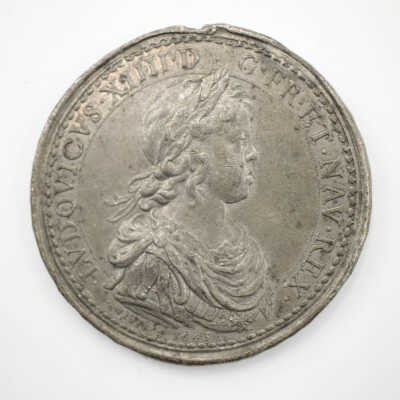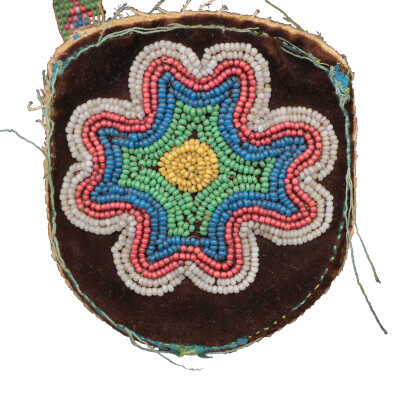Museum Catalog
The Vermont Historical Society houses over 25,000 objects relating to our State's history. Over the next five years all of these items will be digitally documented and placed in this catalog for public use. Items are presented in topical exhibits as well as categorical groupings. Please check back regularly as items will be added monthly. This catalog also houses the Vermont Women's History Database and the Vermont Black History Database.
Search All Categories


Commemorative Coin
Interpretative Labels
Label
Medallion, 1643
France
White metal
Gift of Frederick M. Wiseman, #2017.3.8.1
Designed and struck in 1643, this medal commemorated the ascension of Louis XIV to the throne of France. Since he was only four at the time, his mother, Anne of Austria, served as chair of the ruling regency council. Made of light metal, most likely including lead, this medallion was used as a trade good with the indigenous people of North America. A loop braised onto the top of the medallion allowed it to be worn on a cord. When that loop wore out, an intricate beaded pouch was made by the Innu (Montagnais) owner.
French in Vermont
In 1609 Samuel de Champlain became the first European to set foot in the land that would eventually become Vermont. Paddling south on the lake that now bears his name, he encountered native peoples on both shores, mapped the landscape, and claimed the region for France.
Within 50 years, French colonial ambitions from the north clashed with a rapidly growing English population to the south. European powers took advantage of long-standing inter-tribal animosities and used Native Americans as proxy raiding parties to devastating effect. In July of 1666 the French established a fort and settlement at Fort St. Anne in Isle La Motte, the first European settlement in Vermont.
Over the next century, the French fortified Lake Champlain as far south as Crown Point, building Fort St. Frederick and Carillon (now Ticonderoga). King Louis XV established land grants, known as seigneuries, along the shores of Lake Champlain. French habitants, or settlers, slowly moved into the region. Ultimately, the English victory over the French and the resulting Treaty of Paris in 1763 put eastern North America solidly in English hands. French inhabitants remained in both Canada and Vermont, giving rise to the rich Quebecois culture.
Name/Title
Commemorative Coin
Lexicon
Description
Silver-colored metal coin with a bust of a four-year-old King Louis XIV on one side and his mother, Anne of Austria, the head of the regency council on the other. Louis is shown draped in Roman-style clothing with long, curly hair and a laurel crown. The words "G. FR. ET. NAV. REX. LVDOVICVS. XIII. D." ring the edge. Anne is showing wearing Elizabethan clothing, including a tight bodice, wide fall collar, and three-pointed hood with a cap beneath and veil above. The words "ANNA. D. G. FRET. NAV. REG." ring the edge.
Acquisition
Accession
2017.3
Ethnography
Made/Created
Date made
1643
Dimensions
Dimension Description
Overall
Materials
Material
Metal
Entry/Object ID
2017.3.8a
Context
French coin minted in 1643 upon the death of Louis XIII and ascension of Louis XIV to be traded with indigenous Americans.
Web Links and URLs


Pouch
Interpretative Labels
Label
Bead-Work Pouch, 19th Century
Innu (Montagnais)
Nitassinan
Silk, linen, glass beads
Gift of Frederick M. Wiseman, #2017.3.8.2
This bead-work pouch was created by an Innu craftsman to hold a French medallion offered in trade at some point after 1643. The Innu inhabit Nitassin (Our Land), an unceded area on the north shore of the Gulf of St. Lawrence in the Canadian-defined provinces of Quebec and Labrador. The Innu share a related language and allied with neighbors the Atikamekw, Maliseet, and Algonquin peoples, including the Abenaki.
Samuel de Champlain interacted extensively with the Innu and established Quebec City within Nitassin. Innu guides directed him throughout much of travels, including the trip to what is now called Lake Champlain where he helped defeat an Iroquois war party at Ticonderoga.
This pouch, and the medallion it contained, made its way to an Abenaki family and represents the interplay of various indigenous cultures as well as with French "habitants."
Name/Title
Pouch
Description
Small pouch with long, beaded strap and beaded decoration. The strap is loom beaded with tiny glass beads in green, red, pink, and blue in a repeating geometric pattern. The pouch is constructed of black silk velvet over heavy linen or cotton. Remnants of a green ribbon are around the edge, where it once was bound. The center front of the pouch is decorated with a stylized flower made of tiny glass beads in white, red, blue, green, and yellow. The center back of the pouch is decorated with a leaf or fleur-de-lis made of tiny glass beads in green, blue, and red.
Acquisition
Accession
2017.3
Relationships
Related Places
Place
Chester
Town
Windsor County
County
Vermont
State/Province
United States of America
Country
North America
Dimensions
Dimension Description
Overall
Materials
Material
Linen, Silk, Beads, Ribbon
Context
This pouch was made to hold a Louis XIV medallion (2017.3.8.1) by Abenaki or Innu people.
Lexicon
Ethnography
Made/Created
Time Period
19th Century
Entry/Object ID
2017.3.8b
Web Links and URLs